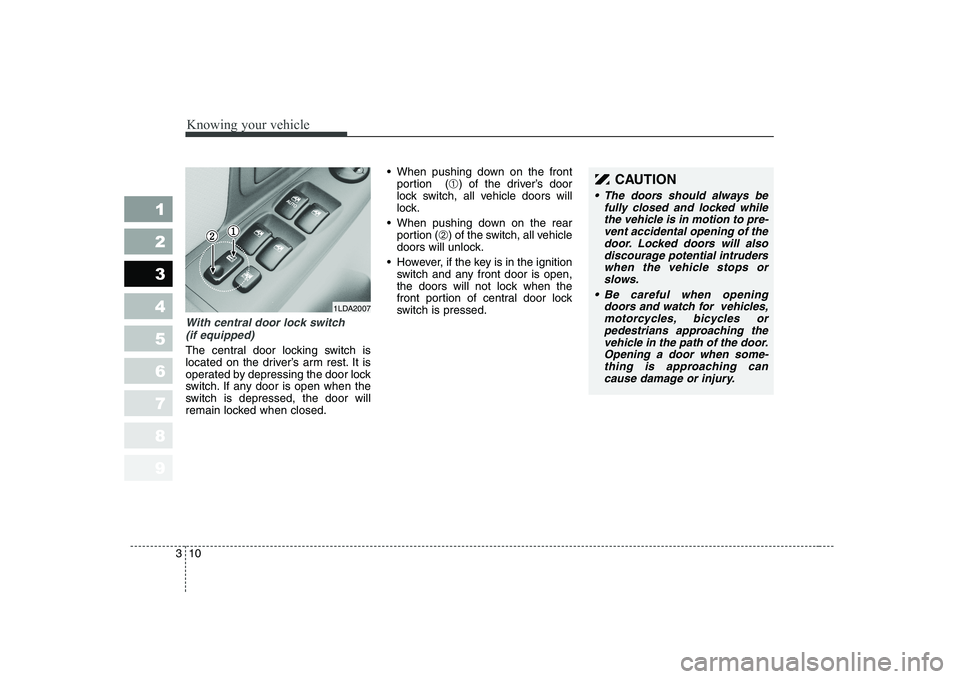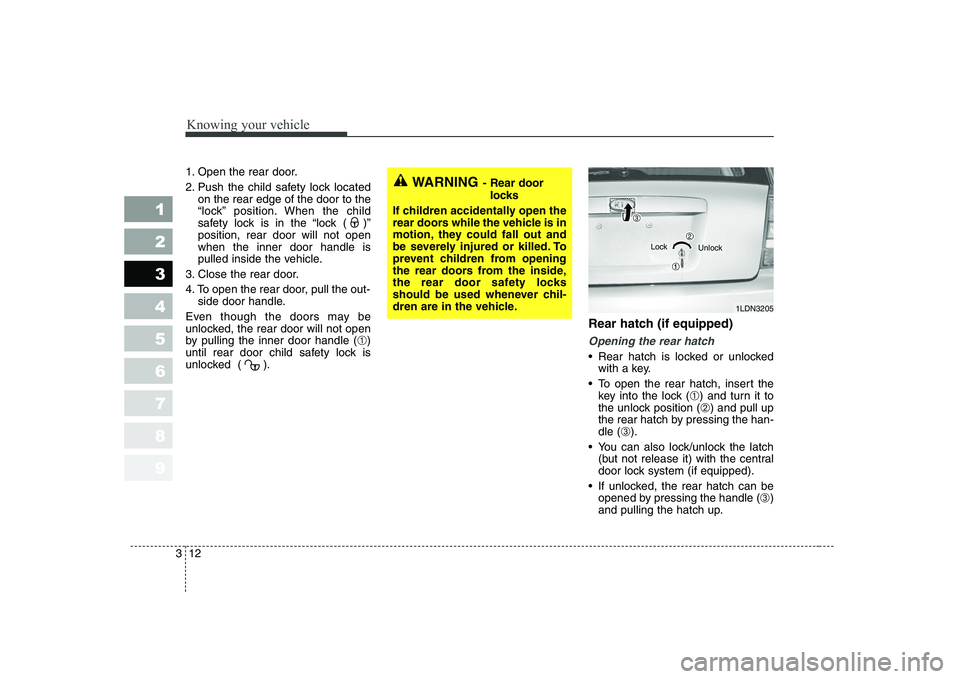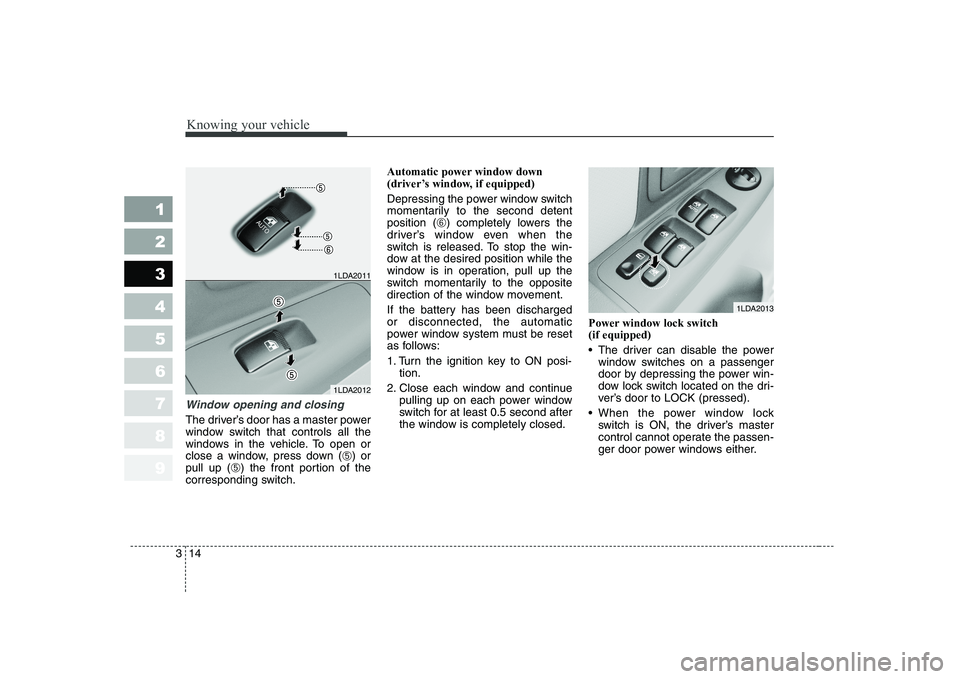Page 20 of 315
39
1 23456789
Knowing your vehicle
✽✽NOTICE
If the door is locked/unlocked multi- ple times in rapid succession with
either the vehicle key or door lockswitch, the system may stop operat-
ing temporarily in order to protect
the circuit and prevent damage tosystem components.
Operating door locks from
inside the vehicle
With the door lock button
To unlock a door, push the door lock button to the “UNLOCK” posi- tion.
To lock a door, push the door lock button ( ➀) to the “lock” position. If
the door is locked, red part ( ➁) of
the knob becomes invisible.
To open a door, pull the door han- dle ( ➂) outward. Front doors cannot be locked if the
ignition key is in the ignition switchand door is open.
If you lock/unlock the front door with door lock button, all vehicle
doors will lock/unlock automatical-
ly. (if equipped)
1LDA2006
Lock Unlock
Page 21 of 315

Knowing your vehicle
10
3
1 23456789
With central door lock switch
(if equipped)
The central door locking switch is
located on the driver’s arm rest. It is
operated by depressing the door lock
switch. If any door is open when the
switch is depressed, the door will
remain locked when closed. When pushing down on the front
portion ( ➀) of the driver’s door
lock switch, all vehicle doors will
lock.
When pushing down on the rear portion ( ➁) of the switch, all vehicle
doors will unlock.
However, if the key is in the ignition switch and any front door is open,
the doors will not lock when the
front portion of central door lock
switch is pressed.
CAUTION
• The doors should always be
fully closed and locked whilethe vehicle is in motion to pre-vent accidental opening of the door. Locked doors will alsodiscourage potential intruderswhen the vehicle stops or slows.
Be careful when opening doors and watch for vehicles,motorcycles, bicycles orpedestrians approaching the vehicle in the path of the door.Opening a door when some-thing is approaching can cause damage or injury.
1LDA2007
Page 22 of 315
311
1 23456789
Knowing your vehicle
Rear door child safety lock
The child safety lock is provided to
help prevent children from acciden-tally opening the rear doors from
inside the vehicle. The rear door
safety locks should be used whenev-
er children are in the vehicle.
1LDA2008
WARNING
Leaving your vehicle unlocked
can invite theft or possible harm
to you or others from someone
hiding in your vehicle while you
are gone. Always remove the
ignition key, engage the parking
brake, close all windows and
lock all doors when leaving your
vehicle unattended.WARNING - Unattended
children
An enclosed vehicle can
become extremely hot, causing
death or severe injury to unat-
tended children or animals who
cannot escape the vehicle.
Furthermore, children might
operate features of the vehicle
that could injure them, or theycould encounter other harm,
possibly from someone gaining
entry to the vehicle. Never leave
children or animals unattended
in your vehicle.
Page 23 of 315

Knowing your vehicle
12
3
1 23456789
1. Open the rear door.
2. Push the child safety lock located
on the rear edge of the door to the
“lock” position. When the child
safety lock is in the “lock ( )”position, rear door will not openwhen the inner door handle is
pulled inside the vehicle.
3. Close the rear door.
4. To open the rear door, pull the out- side door handle.
Even though the doors may be
unlocked, the rear door will not open
by pulling the inner door handle ( ➀)
until rear door child safety lock is
unlocked ( ). Rear hatch (if equipped)
Opening the rear hatch
Rear hatch is locked or unlocked
with a key.
To open the rear hatch, insert the key into the lock ( ➀) and turn it to
the unlock position ( ➁) and pull up
the rear hatch by pressing the han- dle ( ➂).
You can also lock/unlock the latch (but not release it) with the central
door lock system (if equipped).
If unlocked, the rear hatch can be opened by pressing the handle ( ➂)
and pulling the hatch up.
WARNING - Rear door
locks
If children accidentally open the
rear doors while the vehicle is in
motion, they could fall out and
be severely injured or killed. To
prevent children from opening
the rear doors from the inside,
the rear door safety locks
should be used whenever chil-
dren are in the vehicle.
1LDN3205
LockUnlock
Page 24 of 315
313
1 23456789
Knowing your vehicle
Power windows (if equipped) ➀Driver’s door power window switch
➁ Front passenger’s door power win-
dow switch
➂ Rear door (left) power window
switch
➃ Rear door (right) power window
switch
➄ Window opening and closing
(see page 3-14)
➅ Automatic power window down
(Driver’s window, see page 3-14)
➆ Power window lock switch
(see page 3-14)
Power window timer (if equipped)
The power windows can be operat-
ed for approximately 30 seconds
after the ignition key is removed or
turned to the ACC or LOCK posi-
tion. However, if the front doors are
opened, the power windows can-
not be operated even within the 30
seconds after the ignition key
removal.
WINDOWS
1LDA2010
Page 25 of 315

Knowing your vehicle
14
3
1 23456789
Window opening and closing
The driver’s door has a master power
window switch that controls all the
windows in the vehicle. To open or
close a window, press down (
➄) or
pull up ( ➄) the front portion of the
corresponding switch. Automatic power window down
(driver’s window, if equipped)
Depressing the power window switch
momentarily to the second detentposition (
➅) completely lowers the
driver’s window even when the
switch is released. To stop the win-
dow at the desired position while the
window is in operation, pull up the
switch momentarily to the opposite
direction of the window movement.
If the battery has been discharged or disconnected, the automatic
power window system must be reset
as follows:
1. Turn the ignition key to ON posi- tion.
2. Close each window and continue pulling up on each power window
switch for at least 0.5 second after
the window is completely closed. Power window lock switch (if equipped)
The driver can disable the power
window switches on a passenger
door by depressing the power win-
dow lock switch located on the dri-
ver’s door to LOCK (pressed).
When the power window lock switch is ON, the driver’s master
control cannot operate the passen-
ger door power windows either.
1LDA2012
1LDA2011
1LDA2013
Page 42 of 315

331
1 23456789
Knowing your vehicle
WARNING
To obtain maximum benefit from a pre-tensioner seat belt:
The seat belt must be worn correctly.
The seat belt must be adjusted to the correct position.CAUTION
When the pre-tensioner seat
belts are activated, a loud noise may be heard and fine dust,which may appear to be smoke,may be visible in the passenger compartment and are not toxic.
Although, it is harmless, the finedust may cause skin irritationand should not be breathed forprolonged periods. Wash your hands and face thoroughly afteran accident in which the airbagsand/or pre-tensioner seat belts were activated.
CAUTION
Because the sensor that acti- vates the SRS airbag is con-nected with pre-tensioner seatbelt, the SRS airbag warninglight on the instrument panel will blink or illuminate forapproximately 6 seconds afterthe ignition key has beenturned to the “ON” position, then the light should go off.
If the pre-tensioner seat belt is not working properly, thiswarning light will illuminateeven if there is no malfunction of SRS airbag system. If theSRS airbag warning light doesnot illuminate when the igni- tion key is turned to “ON” , orif it remains illuminated afterblinking or illuminating for approximately 6 seconds, or ifit illuminates while the vehicleis being driven, please have an authorized Kia dealerinspect the pre-tensioner seatbelt or SRS airbag system as soon as possible.
Page 47 of 315

Knowing your vehicle
36
3
1 23456789
Safety belt warning light and
chime
As a reminder to the driver and pas-
senger, safety belt warning light will
blink for approximately 6 seconds
each time you turn the ignition switchON.
If the driver’s lap/shoulder belt is not
fastened when the key is turned ON,
the safety belt warning chime sounds
and the safety belt warning light
blinks for approximately 6 seconds.
1GQA2083
CAUTION
Never close the doors on any
part of the lap or shoulder belt.It can damage the safety belt orbuckle which could increase the risk of injury in case of an acci-dent.
WARNING - Safety belt
care
A damaged belt may not give you the protection you need in an accident.
Inspect your safety belts peri- odically for excessive wear or
damage. Pull out each belt
fully and look for fraying, cuts,
burns or other damage. Pull
the safety belt out and let it
retract a number of times.Make sure that the lap/shoul-
der belts return smoothly and
easily into the retractor.
Check the latches to make sure they latch and release
without interference or delay.
Never close the doors on any part of the lap or shoulderbelt.
Any belt not in good condition or in good working order
should be promptly replaced.